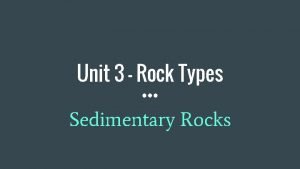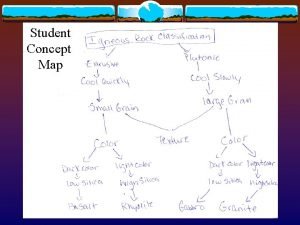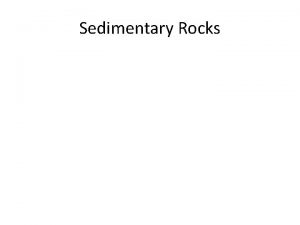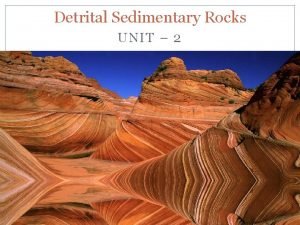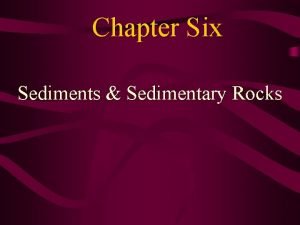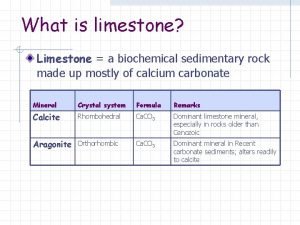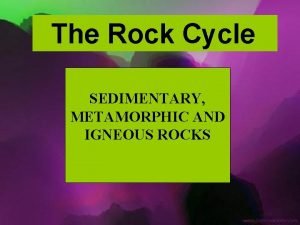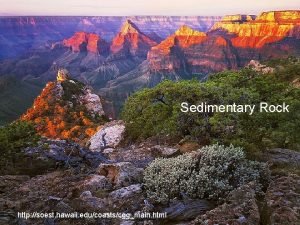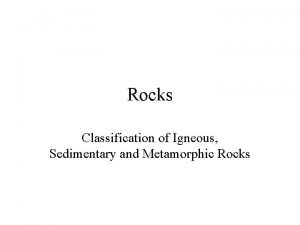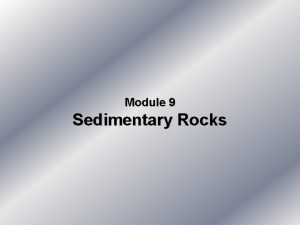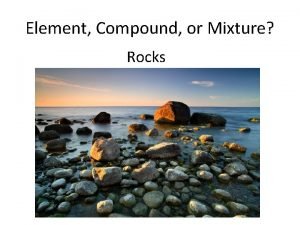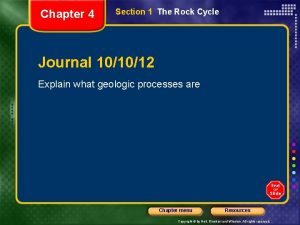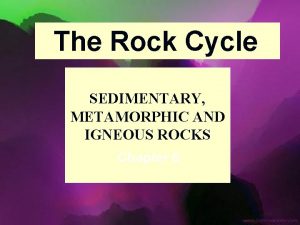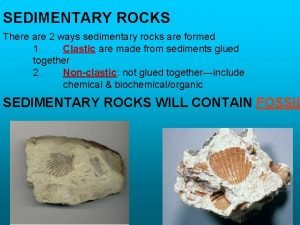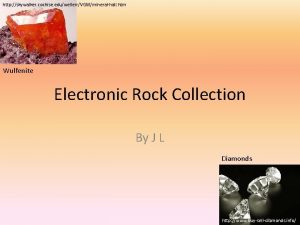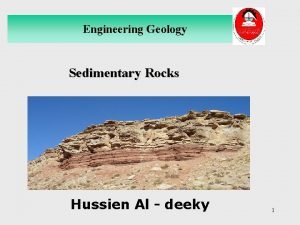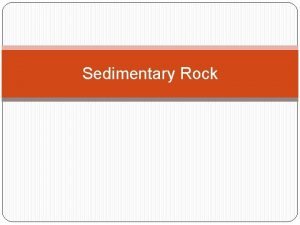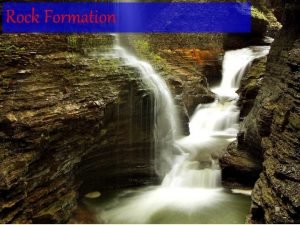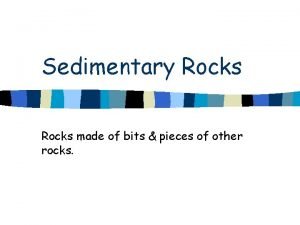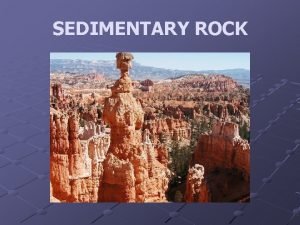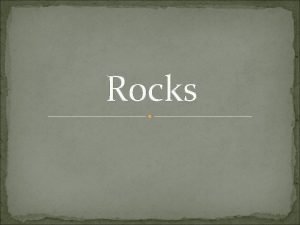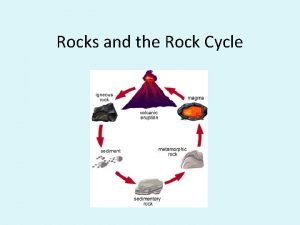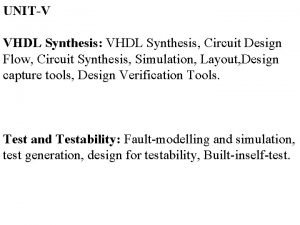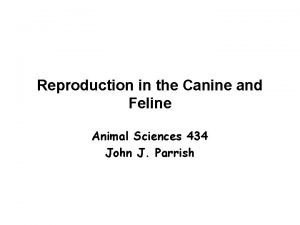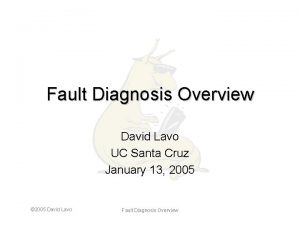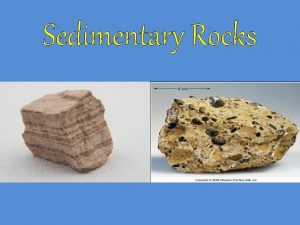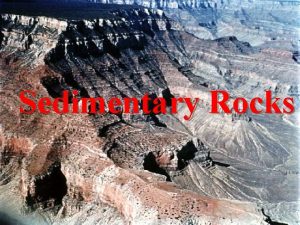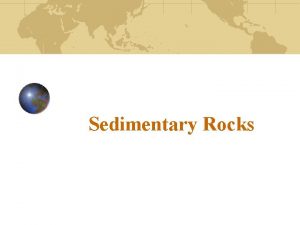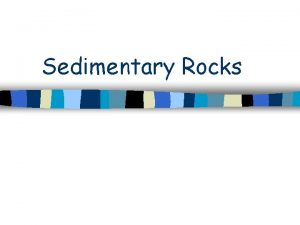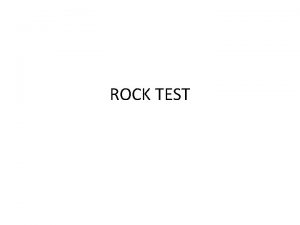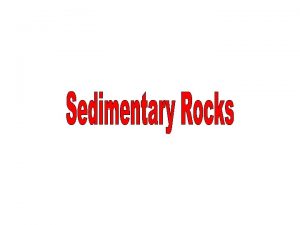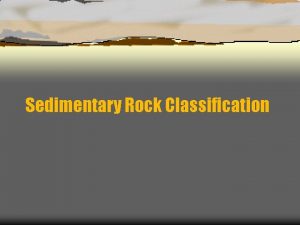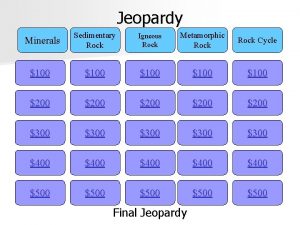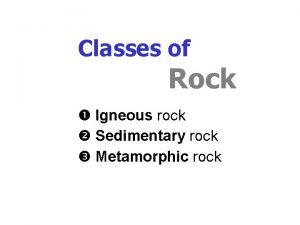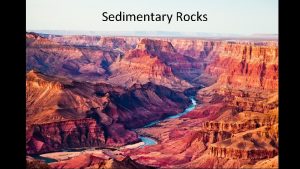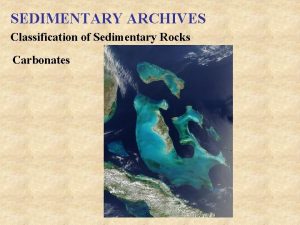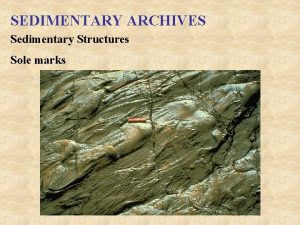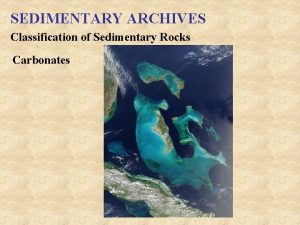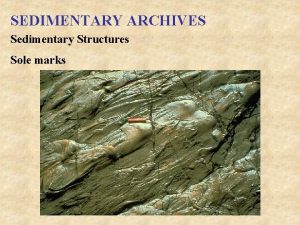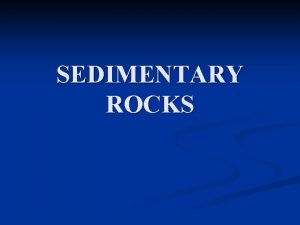Stuck in the Middle with You Sedimentary Rock














































- Slides: 46

Stuck in the Middle with You Sedimentary Rock

How does sedimentary rock form? Fact: Even though the Earth’s crust consists of primarily igneous rock, most of the Earth’s crust is covered in sedimentary rock.

What’s the tallest mountain on Earth? 29, 028 feet

Actually, it’s in Nepal…and the mountains are getting smaller.

Where is Nepal?

Rocks break into pieces or fragments. Pebbles Gravel Sand Silt Clay The breaking of rock is called…

Weathering. I thought it was “Sprinkles. ”

These various size fragments get carried by many different means including Water Wind Gravity Glaciers So these are all agents of …

EROSION!

When the fragments (or sediments) collect, They get buried. Over time, more sediments get added, forming layers of rock that are tightly packed. The laying down of these rock layers is called…

Deposition, of course!

Mt. Everest is getting bigger and smaller at the same time. Huh? Sir Edmund Hillary (left), New Zealander, May 1953 Video: biography 2008

Definition: SEDIMENTARY ROCKS Rock that is formed from hardened sediment COMPACTION AND CEMENTATION These processes result in lithification.

Lith means… ROCK

Textures The major textures, clastic and nonclastic (chemical and organic) are categorized by the way they form and by their distinctive features.

How does sedimentary rock form? Sedimentary rocks are formed of layers of materials that have washed into lakes, rivers, and the ocean. Sedimentary rocks form strata (LAYERS) Sometimes these layers are tilted by earth movements. ONLY sedimentary rocks contain fossils

How do geologists classify sedimentary rock? More important than composition or texture is THE WAY SEDIMENTARY ROCKS FORM. The form by 1. the cementing of compacted sediment. 2. crystallizing out of water. 3. forming from the remains of plants and animals.


The 3 Major Types 1. Clastic (detrital) rocks form from bits and pieces of other rocks. 2. Chemical rocks consist of minerals deposited from a solution. 3. Organic rocks consist of organic matter such as plants and animal remains.

Clastically-Formed Sedimentary Rocks Weathering and erosion by rivers, ice, & wind, carry sediment down to the sea level… (BASE LEVEL) Pebbles, sand, silt, and clay collect on the beach or continental shelf.


Let’s look at how sediments are sorted, deposited, and made into new sedimentary rock. Click here.

Later on, I’m gonna tell these kids a ghost story and make them pee their pants!

Clastically-Formed Sedimentary Rocks Dees rocks are purdy, huh? ? ?

These are CLASTIC!!! Conglomerate Cementation of pebble and gravel forms conglomerate. Conglomerate looks like concrete. Sandstone forms from sands deposited by rivers, or on beaches, or in deserts. Cementation helps to bind the sands together to form solid rock. Shale forms from compaction of clay and mud-sized particles.

Chemically-formed Sedimentary Rocks The water is seas, lakes, and swamps often contain dissolved minerals. The sediments form when the dissolved minerals sink out of solution. The sediments collect and are left after the water evaporates.

Some examples of chemical sed. rocks include Limestone (calcium carbonate) Rock Gypsum (calcium sulfate) Rock Salt (sodium chloride) How does a solution form hard rock?

1. Precipitation! And 2. Evaporation! 3. Crystallization!

The Rock Salt Flats of Utah After the last glacial age (about 10, 000 to 15, 000 years ago), Lake Bonneville in Utah evaporated and left a perfectly flat, 6 foot thick, salt land. Do you remember where we parked?

Organically-Formed Sedimentary Rocks Organically-formed sedimentary rocks form from the remains of plants and animals. Fossil limestone Coal Particularly, bituminous coal (softer and more common)

White Cliffs of Dover A symbolic guard for England, the cliffs over the English Channel are limestone that formed from collected sponges and coral sediment. They can be clearly seen from northern France.




So what have we learned about rock types? Brain. Pop Video

QUIZ TIME!

Try these. READY?

� SEDIMENT 1 Forces in nature break up big rocks into smaller and smaller pieces called ___.

� HALITE 2 Rock salt (and table salt for that matter) is made up of the mineral ___.

� CRYSTALLIZATION 3 Chemical sedimentary rocks, like limestone, will form from the processes of precipitation, evaporation, and ____.

� SANDSTONE 4 The rock formed from sand grains is ____.

� MUD 5 Shale is, more or less, made of hardened ___.

� COAL 6 An organically formed rock that can be made from dead, compressed plant life is called ____.

�CONGLOMERATE 7 ____ can have many different minerals of many different grain size.

� CLASTIC 8 The three subclasses of sedimentary rocks are organic, chemical, and ___.

 Types of igneous sedimentary and metamorphic rocks
Types of igneous sedimentary and metamorphic rocks Rock stages
Rock stages Compaction and cementation
Compaction and cementation Rock cycle
Rock cycle Igneous rocks concept map
Igneous rocks concept map How rocks form
How rocks form What are detrital sedimentary rocks
What are detrital sedimentary rocks Lithification
Lithification Is limestone a biochemical sedimentary rock
Is limestone a biochemical sedimentary rock What is the metamorphic rock cycle
What is the metamorphic rock cycle Sedimentary rocks examples
Sedimentary rocks examples Sedimentary rocks in hawaii
Sedimentary rocks in hawaii Metamorphic
Metamorphic Concept map igneous rocks
Concept map igneous rocks Clastic sedimentary rocks
Clastic sedimentary rocks Are rocks a compound element or mixture
Are rocks a compound element or mixture Chapter 4 section 3 sedimentary rock answer key
Chapter 4 section 3 sedimentary rock answer key Rock cycle song (sedimentary igneous metamorphic)
Rock cycle song (sedimentary igneous metamorphic) Rock cycle
Rock cycle Sedimentary rocks
Sedimentary rocks What is the parent rock of quartzite
What is the parent rock of quartzite Orange sedimentary rock
Orange sedimentary rock Sedimentary rocks
Sedimentary rocks Rock chart
Rock chart Types of clastic sedimentary rocks
Types of clastic sedimentary rocks A process that squeezes, or compacts, sediments
A process that squeezes, or compacts, sediments Sedimentary rocks properties
Sedimentary rocks properties How is chemical sedimentary rock formed
How is chemical sedimentary rock formed Sedimentary rock characteristics
Sedimentary rock characteristics Sedimentary rock formation
Sedimentary rock formation Foliated metamorphic rocks
Foliated metamorphic rocks What kind of rock is this
What kind of rock is this Sedimentary rocks characteristics
Sedimentary rocks characteristics Kayla adair
Kayla adair Stuck in neutral summary
Stuck in neutral summary Cpt trust star worksheet
Cpt trust star worksheet Infinitive simple past
Infinitive simple past Presidential fun facts
Presidential fun facts Defense travel management office
Defense travel management office It takes two stuck in slide
It takes two stuck in slide Rym do pluszcze
Rym do pluszcze Demane and demazana
Demane and demazana Dts stuck at cto submit
Dts stuck at cto submit Stuck
Stuck Design flow of vlsi system
Design flow of vlsi system Dogs season
Dogs season Stuck at fault
Stuck at fault


